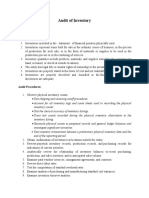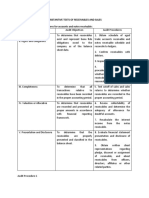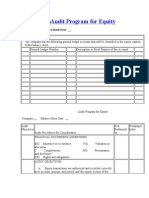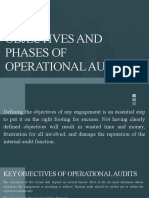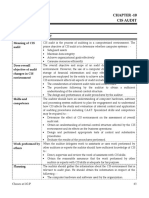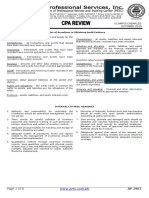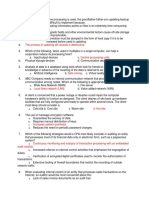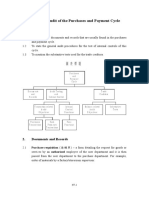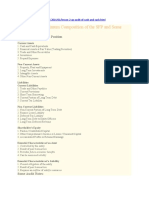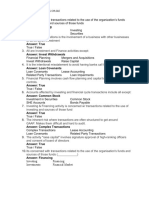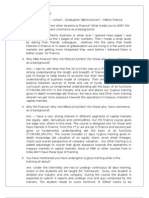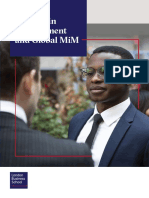Professional Documents
Culture Documents
Audit of Property, Plant, and Equipment
Audit of Property, Plant, and Equipment
Uploaded by
LunaOriginal Description:
Original Title
Copyright
Available Formats
Share this document
Did you find this document useful?
Is this content inappropriate?
Report this DocumentCopyright:
Available Formats
Audit of Property, Plant, and Equipment
Audit of Property, Plant, and Equipment
Uploaded by
LunaCopyright:
Available Formats
BM2008
AUDIT OF PROPERTY, PLANT, AND EQUIPMENT
INTRODUCTION TO AUDIT OF PROPERTY, PLANT, AND EQUIPMENT
The term Property, plant, and equipment (PPE) refer to tangible items that:
a) are held for use in the production or supply of goods or services, for rental to others, or for
administrative purposes; and
b) are expected to be used during more than one period.
PPE normally constitutes a significant portion of the total assets, particularly in a manufacturing entity.
Audit of PPE, therefore, assumes considerable importance. When planning for the audit of PPE, the
auditor considers that the amounts for this PPE is material to the statement of financial position and
expect that the account balances do not necessarily change significantly from year to year.
The auditor normally assesses control risk at a maximum level and performs extensive substantive tests
that emphasize the review of significant additions, disposals, and analytical procedures to test the
provisions for depreciation and depletion. In addition, auditors should also obtain evidence about related
accounts of depreciation expense, accumulated depreciation, lease (rent) expense, impairment loss (if
any), and repairs and maintenance expense.
Components of Property, Plant, and Equipment
The following are the components of PPE, among others:
Land Store and Office Equipment
Land Improvement Furniture and Fixtures
Building Leasehold Improvement
Machinery Bearer Biological Assets
Delivery Equipment
Bearer biological assets (BBA) are matured biological assets held for more than one financial period
capable of bearing consumable biological assets (CBA) to be harvested as agricultural produce. BBA are
held for generating income from the sale of produce; for example,
1. Livestock from which milk is produced
2. Grapevines
3. Oil palm and rubber trees
4. Fruit trees, and
5. Trees from which firewood is harvested while the tree remains.
Bearer biological assets are not agricultural produce but, rather, are self-regenerating. Bearer plant assets
are accounted as PPE under PAS 16, provided it will meet the criteria in the said standard, while bearer
animals are accounted as biological assets under PAS 41. Produce growing on bearer plants is a biological
asset.
Measurement of Property, Plant, and Equipment
• Initial recognition – At cost
• Subsequent measurement – either (for an entire class):
o Cost
o Revaluation Model
Refer to the table on the next page for the summary of the measurement of PPE.
07 Handout 1 *Property of STI
[email protected] Page 1 of 15
BM2008
Purchase Price
Cash basis 1. Cash
2. Lump-sum/basket price - allocate on the basis of relative fair value
On account 1. Invoice price minus cash discount, whether taken or not
Installment Method 1. Cash price equivalent
2. Present value if no cash price equivalent
Issuance of share capital 1. FV of property received
2. FV of share capital
3. Par value or stated value of share capital
Issuance of bonds payable 1. FV of bonds payable
2. FV of property received
3. Face value of bonds payable
• With commercial substance
- No cash involved
1. FV of property given up
2. FV of property received
3. CA of property given up
- With cash involved
FV of property given up + cash paid (payor)
Exchange FV of property given up + cash received (recipient)
• No commercial substance - no gain/loss on exchange
- CA of property given up
- Cash paid is still added; cash received is still deducted
• Trade in
- FV of property given up +cash paid
- Trade in value of the property given up + cash paid
(in effect FV of property received)
• From shareholders = Donated capital
Donation - FV • From non-shareholders = Income if unconditional;
initially Unearned income if conditional
Self-Construction Direct Materials + Direct Labor + Factory Overhead
Depreciation Methods
1. Straight line
• Depreciable amount / useful life
• Depreciable amount x depreciable rate
Depreciable rate = 1 / useful life
2. Group / Composite
• Cost x depreciation rate
Depreciation rate = Annual depreciation / total cost
3. Units of production
• Output x Depreciation rate
Depreciation rate = Depreciable amount / Total estimated output
4. Working hours
• Hours used x depreciation rate
07 Handout 1 *Property of STI
[email protected] Page 2 of 15
BM2008
5. Sum of the years’ digits
• [(life + 1) /2] x life
6. Declining
• Previous carrying amount x depreciation rate
Regular = 1 – (nth root of (Residual value /cost)]
150% = (1 / useful life) x 1.5
200% = (1 / useful life) x 2
7. Retirement
• Cost of asset retired – Proceeds from retirement
8. Replacement
• Replacement cost of asset retired – Proceeds from retirement
9. Inventory
• Recorded balance of asset – Value at period end
AUDIT OBJECTIVES & PROCEDURES
The financial statements assertions, specific audit objectives, and the commonly applied audit procedures
used for the property and equipment are summarized below:
Assertions Audit Objectives Audit Procedures
I. Existence or Occurrence A. To determine whether 1. Obtain or prepare a
property and equipment summary of property and
included in the statement of equipment transactions and
financial position physically analysis of the accumulated
exist. Additions include only depreciation during the year
the capitalizable cost of and reconcile to ledger.
assets purchased, 2. Conduct physical inspection
constructed, or leased and of major acquisition of plant
retirements are removed. and equipment.
II. Completeness B. To determine that property 3. Vouch additions to property
and equipment include all and equipment during the
capitalizable costs and year.
capitalizable costs are not 4. Investigate disposals and
expensed. retirements of property and
equipment during the year.
III. Rights and Obligations C. To determine that the 5. Examine evidence of legal
company has legal title or ownership of property and
equivalent ownership rights equipment.
to property and equipment 6. Examine lease agreement
included in the statement of on property and equipment
financial position and the leased to and from others.
statement of financial 7. Review rental revenue from
position and the related land, buildings and
lease obligation of equipment owned by the
capitalized leased assets is client but leased to others.
recognized.
IV. Valuation or Allocation D. To determine that property 8. Analyze repair and
07 Handout 1 *Property of STI
[email protected] Page 3 of 15
BM2008
Assertions Audit Objectives Audit Procedures
and equipment is stated at maintenance expense
cost and allowances for accounts.
depreciation or depletion are 9. Investigate status of property
computed based on and equipment not in current
acceptable and consistent use.
methods. 10. Test client's computation of
depreciation.
11. Perform analytical
procedures for property and
equipment.
V. Presentation and Disclosure E. To determine that property 12. Review financial statement
and equipment are properly presentation and disclosure
described and classified in for property and equipment
the statement of financial and for related revenue and
position and related expense.
disclosures are adequate.
DISCUSSION OF AUDIT PROCEDURES
1. Reconciliation of Subsidiary Ledger with General Ledger
Primary Audit Objectives: Valuation and Allocation, Completeness, Existence
To provide a focal point for applying substantive tests, the auditor should prepare or obtain a schedule of
plant assets and accumulated depreciation showing balances at the beginning of the year additions and
disposals during the year and balance at the end of the year. Exhibit 1 illustrates a Lead Schedule for
Property and Equipment and Related Accumulated Depreciation.
Beginning balance of plant and equipment assets may be verified by reference to the prior year's audit
working papers. While additions and disposals/retirements may be verified as the audit progresses.
Before making a detailed analysis of change in property accounts, the auditor should be sure that the
amounts in the working paper agree with the ledger balances, both subsidiary and general. Although the
audit testing will be performed on the subsidiary ledger, any audit adjustment will be posted by the
client to the controlling account.
07 Handout 1 *Property of STI
[email protected] Page 4 of 15
BM2008
Exhibit 1: Lead Schedule for Property, Plant, and Equipment
Papasa Ka, Inc.
Property and Equipment
12.31.201A
Final Final
Balance Balance
Description WP# 12/31/201F Additions Disposals 12/31/201A
ASSETS
Land G.1 P 130,000 P 60,000 P 30,000 P 160,000 ✓
Land improvements G.2 50,000 50,000 ✓
Buildings G.3 786,000 160,000 86,000 860,000 ✓
Machinery and
✓
equipment G.4 345,000 85,000 45,000 385,000
Autos and trucks G.5 120,000 30,000 28,000 122,000 ✓
Office furniture &
✓
equipment G.6 86,000 12,000 6,000 92,000
P1,517,000 (✓)^ P 347,000 ^ P 195,000 ^ P1,669,000 ✓^
WTB 1
ACCUMULATED
DEPRECIATION AND
AMORTIZATION
Land improvements G.2 P 20,000 P 5,000 P 25,000 ✓
Buildings G.3 453,000 40,000 P 72,000 421,000 ✓
Machinery and
✓
equipment G.4 126,000 35,000 42,000 119,000
Autos and trucks G.5 65,000 24,000 25,000 64,000 ✓
Office furniture and
✓
equipment G.6 43,000 17,000 3,000 57,000
P 707,000 (✓)^ P 121,000 ^ P 142,000 ^ P 686,000 ✓^
Traced to last year's working
(✓)^
Prepared By Received By paper
Traced to general and subsidiary
✓
Initial Date Initial Date ledger
^ Footed
07 Handout 1 *Property of STI
[email protected] Page 5 of 15
BM2008
Illustrative Case 1: Adapted (Cabrera, 2016)
You are engaged in the examination of the financial statements of the Haven Corporation for the year
ended December 31, 201B. The accompanying analyses of the Property, Plant, and Equipment, and
related accumulated depreciation accounts, have been prepared by the chief accountant of the client.
You have traced the beginning balances to your prior year's audit working papers.
Nine Mines Corporation
Analysis of Property, Plant, and Equipment, and
Related Accumulated Depreciation Accounts
Year Ended December 31, 201E
(In P000's)
Final Assets Per Ledger
Description 12/31/201D Additions Retirements 12/31/201E
Land P422,500 P 5,000 P427,500
Buildings 120,000 17,500 137,500
Machinery and equipment 385,000 40,400 P26,000 399,400
P927,500 P62.900 P26,000 P964,400
Final Accumulated Depreciation Per Ledger
Description 12/31/201D Additions* Retirements 12/31/201E
Buildings P 60,000 P 5,150 P 65,150
Machinery and equipment 173,250 39,220 212,47
P233,250 P44,370 P277,620
* Depreciation expense for the year
All plant assets are depreciated on the straight-line basis (no residual value taken into consideration)
based on the following estimated service lives: building, 25 years, and all other items, 10 years. The
company's policy is to take one half-year's depreciation on all asset additions and disposals during the
year.
Your examination of the 201B transactions revealed the following information:
1. On April 1, the company entered into a 10-year lease contract for a die casting machine, with
annual rentals of P5,000 payable in advance every April 1. The lease is cancelable by either party
(60 days written notice is required), and there is no option to renew the lease or buy the
equipment at the end of the lease. The estimated service life of the machine is 25 years with no
residual value. The company recorded the die casting machine in the Machinery and Equipment
account at P40,400, the present value at the date of the lease, and P2,020 applicable to the
machine has been included.
2. The company completed the construction of a wing on the plant building on June 30. The service
life of the building was not extended. The lowest construction bid received was P17,500, the
amount recorded in the Buildings account. Company personnel constructed the addition at the
cost of P16,000 (materials, P7,500; labor, P5,500; and overhead, P3,000).
3. On August 18, P5,000 was paid for paving and fencing a portion of land owned by the company
and used as a parking lot for employees. The expenditure was charged to the Land account.
07 Handout 1 *Property of STI
[email protected] Page 6 of 15
BM2008
4. The amount shown in the machinery and equipment asset retirement column represents cash
received on September 5 upon disposal of a machine purchased in July 2009 for P48,000. The
chief accountant recorded depreciation expense of P3,500 on this machine in 201B.
5. Cebu City donated land and building appraised at P100,000 and P400,000, respectively, to Haven
Corporation for a plant. On September 1, the company began operating the plant. Since no costs
were involved, the chief accountant made no entry for the above transaction.
REQUIRED:
Prepare the adjusting journal entries that you would propose on December 31, 201B, to adjust the
accounts for the above transactions. Disregard income tax implications. The accounts have not been
closed. Computations should be rounded off to the nearest peso. Use a separate adjusting journal entry
for each of the above five paragraphs.
SOLUTION:
Entries, December 31, 201B
(1) Prepaid Rent 1,250
Rent Expense 3,750
Lease contract payable 35,400
Machinery and equipment 40,400
To correct April 1, 201E entry for lease
of die casting machine
(2) Accumulated depreciation: Machine and equipment 2,020
Depreciation Expense 2,020
To reverse provision for depreciation
on leased machine
(3) Gain on construction of building addition 1,500
Building 1,500
To correct June 30, 201E entry for
addition
(4) Depreciation Expense 317
Accumulated depreciation - Building 317
To correct depreciation on addition
Per audit [(16,000/12) x ½] P667
Per client 350
Additional provision P317
(5) Land Improvement 5,000
Land 5,000
To correct August 13, 201B entry for
paving and fencing of parking lot
(6) Depreciation expense 250
Accumulated depreciation: Land 250
To provide depreciation
on land improvement (1/10 x 112 x P5,000).
07 Handout 1 *Property of STI
[email protected] Page 7 of 15
BM2008
(7) Accumulated depreciation: Machinery and Equipment 20,300
Loss on sale of machinery and equipment 2,800
Machinery and equipment 22,000
Depreciation expense 1,100
To correct Sept. 5, 201B entry for sale
of machinery and depreciation thereon,
and to take up loss on disposal as follows:
Cost P48,000
Accumulated Depreciation
Through 201A P16,800
For 201B 2,400 19,200
Net Book Value P28,800
Proceeds of Sale 26,000
Loss on sale P 2,800
(8) Land 100,000
Buildings 400,000
Depreciation Expense 8,000
Paid-in capital form donated capital 500,000
Accumulated Depreciation: Buildings 8,000
To record at appraised value land and building
donated to the client and to take up depreciation
on buildings as follows: (1/25 x ½ x P400,000)
2. Physical Inspection of Major Additions of Plant and Equipment
Primary Audit Objectives: Existence and Completeness
The auditors usually make a physical inspection of major units of property, plant, and equipment acquired
during the year under audit to determine the existence of the asset. The number of property, plant, and
equipment that needs to be inspected will depend on the auditors' consideration of the risk of material
misstatement and the number of PPE in consideration. The auditor's direction in examining a PPE may
flow in either of the following:
1. Inspect the item of plant and equipment and trace it to the property, plant, and equipment ledger.
This type of procedure provides evidence of completeness of recorded asset.
2. Select items of plant and equipment from the ledger to the physical assets. This type of procedure
provides evidence of existence and condition of assets. However, this procedure does not provide
evidence regarding the ownership of the asset. To verify the ownership of an item of PPE, the
auditor performs the next procedure below.
3. Vouch additions to property during the year. Investigate disposals and retirements.
Primary Audit Objectives: Existence or occurrence, Rights, Completeness, and Valuation
The auditor should examine on a test basis documentation supporting plant asset additions and disposals.
Vendor's invoices and freight bills provide evidence supporting proper valuation and ownership of
purchased assets. While for constructed plant assets, work orders provide the information covering
materials, labor and overhead applied to them. Materials, labor, and direct overhead charges should be
traced to requisitions and time tickets on a test basis. Fixed overhead should be recalculated to support
07 Handout 1 *Property of STI
[email protected] Page 8 of 15
BM2008
the reasonableness of the application rates. The auditor should also determine whether interest should
be capitalized as part of the project.
4. Examine Evidence of Legal Ownership of Property, Plant, and Equipment
Primary Audit Objectives: Rights and obligation
To verify legal ownership of the asset, the auditor must examine evidence such as deeds, transfer
certificate of title (TCT), insurance policy, and property tax bills. Assets owned by the client but held by
third parties under operating lease agreements may be confirmed with the third parties. While assets held
by the client under a capital lease agreement should be verified against the lease contract to determine
whether correct accounting entries were made. For capital or financing leases, the auditor should
recalculate minimum lease payments and evaluate the appropriateness of the discount used in
capitalizing the leases. The ownership of machinery and equipment can be verified by examining the
purchase invoices and contract of sale. While ownership of cars, trucks, and other delivery equipment can
be ascertained by reference to certificates of titles and registration documents.
5. Review rental revenue from the land, buildings, and equipment owned by the client and leased to
others.
Primary Audit Objectives: Rights and obligation
In testing revenue from the rental of land, buildings, and equipment, the auditor should account for all
available rental space and determine the premises occupied by lessees and those which are vacant. The
auditor can obtain the floor plan of the building as well as copies of lease contracts.
6. Analyze Lease, Repair, and Maintenance Expense Accounts
Primary Audit Objectives: Valuation and Allocation, Completeness and Classification
The auditors' principal objective in analyzing the lease (rent), repair, and maintenance expense accounts
is to ensure that all capital expenditure should not be included in these expense accounts. Normally, the
items of lease expense and repairs and maintenance examined by the auditor are those items that involve
a significant amount. For lease expense, the auditor will normally examine the term of the lease contract
to determine if the lease is appropriately classified as operating lease, otherwise, this should be accounted
as an asset and depreciated. For the repairs and maintenance expense accounts, the auditor should obtain
the companies written policy regarding the capitalization of expenditures incurred in relation to a
property, plant, and equipment as a basis in determining the appropriateness of the classification of the
accounts.
7. Examine Impairments of Property, Plant, and Equipment
Primary Audit Objectives: Valuation and allocation
PAS 36 requires that an entity should review assets for impairment whenever events or changes in
circumstances indicate that carrying value may not be recoverable. The management should provide
impairment loss if the carrying amount of an asset is greater than its recoverable amount. Therefore, in
assessing the proprietary of impairment, the auditor should inquire with management their approach in
identifying indicators of impairment and the actions taken as a result of any potential impairment noted.
If an impairment provision was made or the auditor considers it necessary, the auditor ordinarily should
perform the following procedures:
1. Evaluate the appropriateness of the valuation model and assumptions used;
07 Handout 1 *Property of STI
[email protected] Page 9 of 15
BM2008
2. Assess the reasonableness of management's estimates; and
3. Evaluate the accuracy, completeness, and the relevance of the important data on which the
estimates or measurements are based.
8. Test the Provision for Depreciation or Depletion
Primary Audit Objectives: Valuation and Allocation, and Accuracy
Depreciation or depletion is an example of an accounting estimate. PSA 540 (revised and redrafted)
requires that in evaluating accounting estimates, auditors first obtain an understanding of the client's
process and controls in developing accounting estimates. In auditing depreciation or depletion, the
auditor's objective is to obtain sufficient appropriate audit evidence about whether:
a. Depreciation or depletion recognized in the financial statements are reasonable; and
b. Related disclosures required in the financial statements are adequate.
The following are audit procedures to test the reasonableness of depreciation and depletion:
1. Review the depreciation policies set forth in the company manuals and determine if it is applied
consistently;
2. Obtain or prepare a summary analysis of accumulated depreciation for the major property
classifications as shown by the general ledger control accounts, listing beginning balances,
provisions for depreciation during the year, disposals, retirements, and ending balances.
a. Compare beginning balances with the audited amounts in last year's working papers; and
b. Determine that the totals of accumulated depreciation recorded in the plant and equipment
subsidiary records agree with the applicable general ledger controlling accounts.
3. Test the provisions of depreciation.
a. Assess the reasonableness of the depreciation methods and rates used to calculate the
depreciation provision by comparing it with the methods and rates used in the prior years and
investigate any variances;
b. For assets acquired or disposed of during the year, check whether depreciation was provided
based on the accounting policy of the company;
c. Check the computation of depreciation by performing independent recalculation; and
d. Compare credits to accumulated depreciation for the year with the debits to depreciation
expense.
4. Test deductions from accumulated depreciation for assets retired.
a. Trace deductions to the working paper analyzing retirements of assets during the year; and
b. Test accuracy of accumulated depreciation to date of retirement.
5. Perform analytical procedures for depreciation.
a. Compute the ratio of depreciation expense to total cost of plant and compare with prior years;
and
b. Compare the percentage relationships between accumulated depreciation and the related
property accounts with those in prior years. Inquire with management any significant
variations from the normal depreciation.
When the entity's assets include natural resources, the auditor should review the geological surveys, the
results of the entity's explorations and other information used by the entity in estimating its recoverable
quantities. Since this involves a special area, the auditor may need to consult an expert.
Note: In analyzing depreciation or depletion, exclude land in the analysis since this is not a depreciable
asset.
07 Handout 1 *Property of STI
[email protected] Page 10 of 15
BM2008
Illustrative Case 2: Adapted (Ocampo)
The following data relate to the Plant Assets account of Moose Inc. at December 31, 201D:
Plant Assets
K G Q C
Original Cost P87,500 P127,500 P200,000 P200,000
Year Purchases 201A 201B 201C 201D
Useful Life 10 years 37,500 15 years 10 years
hours
Salvage value P7,750 P7,500 P12,500 P12,500
Depreciation method SYD Activity Straight-Line Double
declining-
balance
Note: In the year an asset is purchased, Moose, Inc, does not record any depreciation expense on the asset
In the year an asset is retired or traded in Moose, Inc takes a full year depreciation on the asset.
The following transaction occurred during 201E:
a) On May 5, Asset K was sold for P32,000 cash.
b) On December 31, it was determined that asset G had used 5,250 hours during 201E
c) On December 31, before computing depreciation expense on Asset Q, the management of Moose,
Inc. decide the useful life remaining from January 1, 201E was 10 years.
d) On December 31, it was discovered that a plant asset purchased in 201E had been exposed
completely in that year. This asset costs P55,000 and has useful life of 10 years and no salvage
value. Management has decided to use the double-declining balance for this asset, which can be
referred to as "Asset R".
QUESTIONS: (Disregard tax implications)
1. How much is the gain or loss on sale of Asset K?
2. How much is the depreciation of Asset Q for 201E?
3. The adjusting entry to correct the error or failure to capitalize Asset R would include a debit/credit
to Retained Earnings of ___________
4. How much is the adjusted balance of Plant Assets as of December 31, 201E
5. How much is the total depreciation expense for 201E?
Suggested Answer:
1. Gain on sale – P10,250
2. Depreciation of Asset Q for 201E – P15,000
3. Asset R P55,000
Retained Earnings P55,000
4. Asset K P -
Asset G 127,500
Asset Q 200,000
Asset C 200,000
Asset R 55,000
Plant Assets, 12/31/1E P582,500
07 Handout 1 *Property of STI
[email protected] Page 11 of 15
BM2008
9. Perform Analytical Procedures for Property, Plant and Equipment
Primary Audit Objectives: Existence/occurrence, Rights and obligations, Completeness, and Valuation
and allocation
The specific trends and ratios used in judging the overall reasonableness of recorded amounts for
property, plant, and equipment will vary with the nature of the client's operation. Among the ratios and
trends commonly used by auditors for this purpose are the following:
1. Ratio analysis
a. Total cost of plant assets divided by annual output in pesos, pounds or other units.
b. Total cost of plant assets divided by cost of goods sold.
c. Total depreciation expense divided by total cost of property, plant, and equipment.
2. Trend analysis
a. Comparison of repairs and maintenance expense on a monthly basis and from year to year.
b. Comparison of acquisitions for the current year with prior years.
c. Comparison of retirements for the current year with prior years.
It may be clarified that the foregoing is only an illustrative list of analytical review procedures which an
auditor may employ in carrying out an audit of property, plant, and equipment and its related account.
The exact nature of analytical review procedures to be applied in a specific situation is a matter of
professional judgment of the auditor.
10. Evaluate Financial Statement Presentation and Disclosures for Plant Assets and for Related Revenue
and Expenses
Primary Audit Objectives: Presentation and disclosure
For each class of property, plant, and equipment, the auditor should check whether the entity has
disclosed the following requirements under PAS 16:
1. Basis for measuring carrying amount;
2. Depreciation method(s) used;
3. Useful lives or depreciation rates used;
4. Gross carrying amount and accumulated depreciation and impairment losses at the beginning and
end of the period;
5. Reconciliation of the carrying amount at the beginning and the end of the period;
6. Restrictions on title;
7. Expenditures to construct property, plant, and equipment during the period;
8. Commitments to acquire property, plant, and equipment; and
9. Compensation from third parties for items of property, plant, and equipment that were impaired,
lost or given up that is included in profit or loss.
The auditor also should be satisfied that any revaluation surplus should be properly presented as part of
other comprehensive income in the statement of comprehensive income. Items of property, plant, and
equipment are presented as non-current asset in a line item in the statement of financial position as
"Property, Plant, and Equipment".
07 Handout 1 *Property of STI
[email protected] Page 12 of 15
BM2008
Illustrative Case 3:
The following items are included in the PPE section of the audited statement of financial position of
DRUMS CORP. as of December 31, 201A:
Land P 3,450,000
Buildings 13,350,000
Leasehold improvements 9,900,000
Machinery and equipment 13,125,000
The following transactions occurred during 201B:
1. Land A was acquired for P12,750,000. In connection with the acquisition, Drums paid a P765,000
commission to a real estate agent. Costs of P525,000 were incurred to clear the land. During the
course of clearing the land, timber and gravel were recovered and sold for P195,000.
2. Land B with an old building was acquired for P7,500,000. On the acquisition date, the fair value of the
land was P4,200,000 and the fair value of the building was P1,800,000. The old building was
demolished at a cost of P615,000 shortly after acquisition. A new building to be used as an owner-
occupied property was constructed for P4,950,000 plus the following costs:
Excavation fees P 570,000
Architectural design fees 165,000
Building permit fee 37,500
Imputed interest on funds used during construction (stock
financing) 127,500
The building was completed and occupied on December 30, 201B.
3. Land C was acquired for P9,750,000 with the intention of selling it within 12 months from the date of
purchase.
4. During December 201B, costs of P1,335,000 were incurred to improve leased office space. The related
lease will terminate on the December 31,201D and is not expected to be renewed.
5. A group of machines was purchased under a royalty agreement that provides for payment of royalties
based on units of production for the machines. The invoice price of the machines was P1,305,000,
freight costs were P49,500, installation costs were P36,000, and royalty payments for 201B were
P262,500.
Based on the preceding information, determine the balances of the following PPE items as of December
31, 201B:
1. Land
2. Buildings
3. Leasehold Improvements
4. Machinery and Equipment
5. How should Land C should be reported in the company's statement of financial position at year-end?
07 Handout 1 *Property of STI
[email protected] Page 13 of 15
BM2008
LAPSING SCHEDULE
Lapsing schedule is a worksheet containing specific accounting data about fixed assets such as the original
purchase cost, useful life, accumulated depreciation, additions, sales of assets, and so on. Lapsing
schedule is ordinarily provided by the audit client and may slightly differ from one entity to another.
Presented below is an example of a lapsing schedule, which is essential in conducting an audit of PPE.
Current
Classification Date Useful Year Carrying Carrying
Description Original Cost Method Accumulated
of PPE Acquired Life Depreciation Value - Beg Value - End
Depreciation
Expense
Land Makati St. 1/1/201B 6,000,000.00 6,000,000.00 6,000,000.00
Building Office Building 1/1/201B 5,000,000.00 SL 20 250,000.00 250,000.00 5,000,000.00 4,750,000.00
Building Factory 1/1/201A 3,500,000.00 DDB 20 315,000.00 665,000.00 3,150,000.00 2,835,000.00
IT Equipment Computers 1/1/201A 2,000,000.00 SL 8 250,000.00 500,000.00 1,750,000.00 1,500,000.00
And so on…
Sample Audit Program - Property, Plant & Equipment
Audit objective/Possible Audit procedure Comments
Misstatement
Analytical Procedures:
Misstatement in PPE and Compare prior year balances in No exceptions noted.
depreciation PPE with current year.
Misstatement in depreciation Compute the ratio of No significant differences
expense and accumulated depreciation charge to the noted.
depreciation. related PPE account, and
compare with prior year.
Expensing amounts should be Compare repairs and No exceptions noted. No
capitalized. maintenance expense with significant difference from
previous years. previous period.
Substantive Procedures:
Accuracy Cast the PPE lead schedule. No exceptions noted.
Trace the total to the general
ledger.
Valuation and allocation Obtained detailed schedules for NBV for Tools on lead schedule
additions and disposals of PPE does not cross-cast.
and agree amounts to the PPE Depreciation rate for
lead schedule. Renovation per lead schedule is
6% but 11% on detailed
schedule.
Valuation and Allocation Test depreciation calculations Motor vehicle acquisition of
for a sample of PPE. Toyota Innova on 16.19.201A –
not depreciated during the
year. Should have incurred a
depreciation of P59,000.
Existence Vouch additions and disposals No exceptions noted.
to supplier invoices or other
supporting documents.
07 Handout 1 *Property of STI
[email protected] Page 14 of 15
BM2008
Verify the existence of a sample
of PPE by examining them
physically.
Completeness Physically examine a sample of No exceptions noted.
PPE and trace them to the PPE
detailed schedule.
Classification Review the 'repairs and No exceptions noted.
maintenance’ account to
uncover items that should be
capitalized.
Cut-off Review purchase or disposal No exceptions noted.
transactions before & after the
reporting date for proper cut-
off.
Rights and Obligations For land, buildings, etc. No exceptions noted on land
- examine the title deeds for and buildings.
proof of ownership. Registration card should have
For motor vehicles, heavy been stamped pledged because
equipment, etc. machinery is pledged as
- examine registration cards for security.
proof of ownership.
Presentation & Disclosure Examine loan agreements for One security agreement with
PPE pledged as security for SGV Company.
loans.
References
(2019, November 15). Retrieved from Scribd: Scribd.com
Asuncion, D. J., Ngina, M. A., & Escala, R. F. (2018). Applied Auditing Book 1 of 2. Baguio: Real Excellence
Publishing.
Cabrera, M. B., & Cabrera, G. B. (2017). Applied Auditing. Maila: GIC Enterprises & Co., Inc.
Roque, G. S. (2016 - 2017). CPA Examination Reviewer: Auditing Problem. Manila: GIC Enterprises & Co.,
Inc.
07 Handout 1 *Property of STI
[email protected] Page 15 of 15
You might also like
- Audit of InventoryDocument5 pagesAudit of InventoryMa. Hazel Donita DiazNoch keine Bewertungen
- Substantive Tests of Receivables and SalesDocument4 pagesSubstantive Tests of Receivables and SalesKeith Joshua Gabiason100% (1)
- Audit Program For EquityDocument10 pagesAudit Program For EquityJovelyn Bacit0% (1)
- Audit Program-Long Term DebtDocument11 pagesAudit Program-Long Term DebtRoemi Rivera Robedizo100% (3)
- Objectives and Phases of Operational AuditsDocument12 pagesObjectives and Phases of Operational AuditsJacqueline Ortega100% (2)
- MahadFX Course 5Document11 pagesMahadFX Course 5Tuong Nguyen50% (2)
- Cash TheoriesDocument21 pagesCash TheoriesMark Gelo WinchesterNoch keine Bewertungen
- Student Copy Paf-Kiet Copy Bank Copy: Amount Payable: Rs.59950 Amount Payable: Rs.59950 Amount Payable: Rs.59950Document1 pageStudent Copy Paf-Kiet Copy Bank Copy: Amount Payable: Rs.59950 Amount Payable: Rs.59950 Amount Payable: Rs.59950ebadbaddevNoch keine Bewertungen
- Agrarian Law Salient FeaturesDocument3 pagesAgrarian Law Salient FeaturesKim John VillaNoch keine Bewertungen
- ASCP IO Safety Stock Calc Lead TimeDocument13 pagesASCP IO Safety Stock Calc Lead TimeMohan Srireddy100% (1)
- PSBA - Property, Plant and EquipmentDocument13 pagesPSBA - Property, Plant and EquipmentAbdulmajed Unda MimbantasNoch keine Bewertungen
- AP - Property, Plant and EquipmentDocument6 pagesAP - Property, Plant and EquipmentRhuejane Gay MaquilingNoch keine Bewertungen
- Template - Assignment - Audit of ReceivablesDocument6 pagesTemplate - Assignment - Audit of ReceivablesEdemson NavalesNoch keine Bewertungen
- Auditing Problems: Audit of ReceivablesDocument4 pagesAuditing Problems: Audit of ReceivablesLaong laanNoch keine Bewertungen
- Chapter 20 The Computer EnvironmentDocument13 pagesChapter 20 The Computer EnvironmentClar Aaron Bautista100% (1)
- 10.1. Cis Environment: Meaning of CIS AuditDocument13 pages10.1. Cis Environment: Meaning of CIS AuditShubham BhatiaNoch keine Bewertungen
- Audit of Investment-LectureDocument15 pagesAudit of Investment-LecturemoNoch keine Bewertungen
- Auditing Problems Ocampo/Cabarles AP.1901-Audit of Inventories OCTOBER 2015Document8 pagesAuditing Problems Ocampo/Cabarles AP.1901-Audit of Inventories OCTOBER 2015AngelouNoch keine Bewertungen
- Audit in Cis EnvironmentDocument9 pagesAudit in Cis EnvironmentJewel Mae MercadoNoch keine Bewertungen
- Auditing and Assurance Concepts and Applications 2Document6 pagesAuditing and Assurance Concepts and Applications 2mhadzmp100% (1)
- Audit of Long-Term LiabilitiesDocument43 pagesAudit of Long-Term LiabilitiesEva Dagus0% (1)
- Chapter FiveDocument14 pagesChapter Fivemubarek oumerNoch keine Bewertungen
- Module IV. Substantive TestingDocument22 pagesModule IV. Substantive TestingAldrin Zolina100% (2)
- The Audit of InventoriesDocument6 pagesThe Audit of InventoriesIftekhar Ifte100% (3)
- Expert Q&A SolutionsDocument3 pagesExpert Q&A SolutionsSitiNadyaSefrilyNoch keine Bewertungen
- Audit of Investments: Investment PurposeDocument11 pagesAudit of Investments: Investment PurposeTracy Miranda BognotNoch keine Bewertungen
- Auditing Theory 3rd Examination (Answer Key)Document13 pagesAuditing Theory 3rd Examination (Answer Key)KathleenNoch keine Bewertungen
- DSWD NCR - Audit Program Semi Expendable and PPEDocument4 pagesDSWD NCR - Audit Program Semi Expendable and PPEAnn MarinNoch keine Bewertungen
- Cash Price Equivalent at The Deferred Beyond Normal CreditDocument5 pagesCash Price Equivalent at The Deferred Beyond Normal CreditSharmin ReulaNoch keine Bewertungen
- The Audit of LiabilitiesDocument3 pagesThe Audit of LiabilitiesIftekhar Ifte100% (4)
- FINANCING CYCLE AuditDocument12 pagesFINANCING CYCLE AuditEl Yang100% (1)
- Auditing The Revenue CycleDocument7 pagesAuditing The Revenue CycleYoite MiharuNoch keine Bewertungen
- Substantive Testing and Documentation 2Document3 pagesSubstantive Testing and Documentation 2Rose Medina BarondaNoch keine Bewertungen
- IT Audit 4ed SM Ch10Document45 pagesIT Audit 4ed SM Ch10randomlungs121223Noch keine Bewertungen
- Pfrs Update 2022Document21 pagesPfrs Update 2022Robert CastilloNoch keine Bewertungen
- Overview of Risk Based Audit ProcessDocument17 pagesOverview of Risk Based Audit ProcessAira Nhaira Mecate100% (1)
- Final Exam Gbermic Multiple ChoiceDocument5 pagesFinal Exam Gbermic Multiple ChoiceMarie GarpiaNoch keine Bewertungen
- Substantive Test of InvestmentsDocument57 pagesSubstantive Test of Investmentsjulia4razoNoch keine Bewertungen
- Estimating InventoriesDocument3 pagesEstimating Inventorieskeisha santosNoch keine Bewertungen
- Audit ProbDocument16 pagesAudit ProbJewel Mae Mercado100% (1)
- Unit 6 AUDIT OF INTANGIBLE ASSETS Lecture Notes 2020Document11 pagesUnit 6 AUDIT OF INTANGIBLE ASSETS Lecture Notes 2020Marynelle Labrador Sevilla100% (1)
- Auditing Reviewer and AnswersDocument15 pagesAuditing Reviewer and AnswersElaine Joyce GarciaNoch keine Bewertungen
- Auditing Specialized IndustryDocument2 pagesAuditing Specialized Industryangelicadecipulo0828Noch keine Bewertungen
- 7 Audit of Shareholders Equity and Related Accounts Dlsau Integ t31920Document5 pages7 Audit of Shareholders Equity and Related Accounts Dlsau Integ t31920Heidee ManliclicNoch keine Bewertungen
- Auditing 2&3 Theories Reviewer CompilationDocument9 pagesAuditing 2&3 Theories Reviewer CompilationPaupauNoch keine Bewertungen
- 17002Document2 pages17002Alvin YercNoch keine Bewertungen
- Problem No. 1 - Audit of Property, Plant, and Equipment (Ppe)Document2 pagesProblem No. 1 - Audit of Property, Plant, and Equipment (Ppe)John LuNoch keine Bewertungen
- Audit of Prepayments and Intangible AssetsDocument4 pagesAudit of Prepayments and Intangible AssetsGille Rosa Abajar100% (2)
- First PreboardDocument5 pagesFirst PreboardRodmae VersonNoch keine Bewertungen
- AT03 Framework of Audit Evidence DocumentationDocument5 pagesAT03 Framework of Audit Evidence DocumentationVillena Divina VictoriaNoch keine Bewertungen
- QUIZ 2 Airline IndustryDocument4 pagesQUIZ 2 Airline IndustrySia DLSL100% (1)
- 1 Nature and Objectives of Operational Audit EngagementDocument32 pages1 Nature and Objectives of Operational Audit EngagementMay Angelica TenezaNoch keine Bewertungen
- Chapter 37 Financial StatementsDocument68 pagesChapter 37 Financial StatementsheyheyNoch keine Bewertungen
- Quiz 2 AuditingDocument4 pagesQuiz 2 AuditingCrissa Mae Falsis100% (1)
- Chapter 7 Audit of The Purchases and Payment CycleDocument34 pagesChapter 7 Audit of The Purchases and Payment CycleRishika RapoleNoch keine Bewertungen
- PFRS 3, Business CombinationsDocument39 pagesPFRS 3, Business Combinationsjulia4razoNoch keine Bewertungen
- Audit of Cash PDFDocument11 pagesAudit of Cash PDFRyan Prado AndayaNoch keine Bewertungen
- Perez Long Quiz Auditing and Assurance Concepts and ApplicationDocument7 pagesPerez Long Quiz Auditing and Assurance Concepts and ApplicationMitch MinglanaNoch keine Bewertungen
- Lesson 1 AP: Minimum Composition of The SFP and Some Audit NotesDocument14 pagesLesson 1 AP: Minimum Composition of The SFP and Some Audit NotesDebs FanogaNoch keine Bewertungen
- AUDIT II CH-3 EDITED Receivable & SalesDocument24 pagesAUDIT II CH-3 EDITED Receivable & SalesQabsoo FiniinsaaNoch keine Bewertungen
- Investing and Financing Cycle QuizDocument1 pageInvesting and Financing Cycle QuizAira Jaimee GonzalesNoch keine Bewertungen
- Specialized Industry Finals - With AnswerDocument16 pagesSpecialized Industry Finals - With AnswerXXXXXXXXXXXXXXXXXXNoch keine Bewertungen
- Substantive Test of Property, Plant and Equipment (PPE)Document24 pagesSubstantive Test of Property, Plant and Equipment (PPE)Eunice Tayag RonquilloNoch keine Bewertungen
- Property Plant Equipment PART 1 FINALDocument22 pagesProperty Plant Equipment PART 1 FINALJames R JunioNoch keine Bewertungen
- Model Summary: A. Predictors: (Constant), ShelfspaceDocument3 pagesModel Summary: A. Predictors: (Constant), ShelfspaceLunaNoch keine Bewertungen
- Manozo, Pamela L. BSA3-A 8 Task Performance 1: Spss SolutionDocument3 pagesManozo, Pamela L. BSA3-A 8 Task Performance 1: Spss SolutionLunaNoch keine Bewertungen
- Aa 3HM1Document2 pagesAa 3HM1LunaNoch keine Bewertungen
- Invoice Number FOB Terms Date Shipped Date Recorded Estimated Date of Delivery Sales InventoryDocument2 pagesInvoice Number FOB Terms Date Shipped Date Recorded Estimated Date of Delivery Sales InventoryLunaNoch keine Bewertungen
- 06 Task Performance 1Document5 pages06 Task Performance 1LunaNoch keine Bewertungen
- The Following Transactions Occurred During 201G:: Property of STIDocument2 pagesThe Following Transactions Occurred During 201G:: Property of STILunaNoch keine Bewertungen
- Homework Answer The Following Independent Audit Cases On A Separate Sheet of Paper. Show Your Computations. Audit Case 1 (5 Items X 5 Points)Document2 pagesHomework Answer The Following Independent Audit Cases On A Separate Sheet of Paper. Show Your Computations. Audit Case 1 (5 Items X 5 Points)LunaNoch keine Bewertungen
- IA3 Manozo 4quiz1Document1 pageIA3 Manozo 4quiz1LunaNoch keine Bewertungen
- Geog PrinciplesDocument23 pagesGeog PrinciplesMarguerita SotiriouNoch keine Bewertungen
- Savills Vietnam Industrial Report 1570152160Document16 pagesSavills Vietnam Industrial Report 1570152160Vo DUC VUNoch keine Bewertungen
- Assessment of Security Analysis and Portfolio Management in Indian Stock MarketDocument5 pagesAssessment of Security Analysis and Portfolio Management in Indian Stock MarketEditor IJTSRDNoch keine Bewertungen
- Interview QuestionsDocument20 pagesInterview QuestionsJatin PathakNoch keine Bewertungen
- Research Paper On Sme Banking in BangladeshDocument5 pagesResearch Paper On Sme Banking in Bangladeshmgrekccnd100% (1)
- Cityam 2013-02-14Document35 pagesCityam 2013-02-14City A.M.Noch keine Bewertungen
- The Eight RS of HRDocument7 pagesThe Eight RS of HRIan CalicaNoch keine Bewertungen
- Seal BillDocument3 pagesSeal BillprintNoch keine Bewertungen
- Introduction To Corporate Social Responsibility by Dr.R.MANGALESWARANDocument37 pagesIntroduction To Corporate Social Responsibility by Dr.R.MANGALESWARANMangal Eswaran0% (1)
- Biofloc QuotationDocument1 pageBiofloc QuotationAbhishek TyagiNoch keine Bewertungen
- EMBA Week 2 AssignmentDocument3 pagesEMBA Week 2 AssignmentShazia SaifNoch keine Bewertungen
- GiordanoDocument13 pagesGiordanovineetvj7Noch keine Bewertungen
- Mining Sector Strategic Environmental and Social Assessment (SESA)Document12 pagesMining Sector Strategic Environmental and Social Assessment (SESA)FernandoNoch keine Bewertungen
- Description Methodology Download PDFDocument30 pagesDescription Methodology Download PDFZelalem HassenNoch keine Bewertungen
- First Quarter Summative Test TLE 10 AFADocument2 pagesFirst Quarter Summative Test TLE 10 AFAmark gonzalesNoch keine Bewertungen
- Employer BrandingDocument15 pagesEmployer BrandingVishant ChopraNoch keine Bewertungen
- MPCDocument67 pagesMPCpkj009Noch keine Bewertungen
- MIM BrochureDocument25 pagesMIM BrochureSaurabh BajpeyeeNoch keine Bewertungen
- Iqra University - Karachi Faculty of Business AdministrationDocument31 pagesIqra University - Karachi Faculty of Business Administrationsyed aliNoch keine Bewertungen
- 3Document49 pages3Preet ChahalNoch keine Bewertungen
- Outline: Why Study Economics?Document31 pagesOutline: Why Study Economics?Leann TaguilasoNoch keine Bewertungen
- Academic Writing Task 1 Compilation 3Document27 pagesAcademic Writing Task 1 Compilation 3sydneyNoch keine Bewertungen
- Reclaiming Agency ProspectusDocument12 pagesReclaiming Agency ProspectusSonalNoch keine Bewertungen
- Country Analysis Thailand - Global Business EnvironmentDocument47 pagesCountry Analysis Thailand - Global Business EnvironmentXavier Koo100% (2)
- CL3Document66 pagesCL3Shashank ManchandaNoch keine Bewertungen
- Rastriya Banijya Bank Level 4 Admin Assistant SyllabusDocument6 pagesRastriya Banijya Bank Level 4 Admin Assistant SyllabusKai Tondey50% (2)
